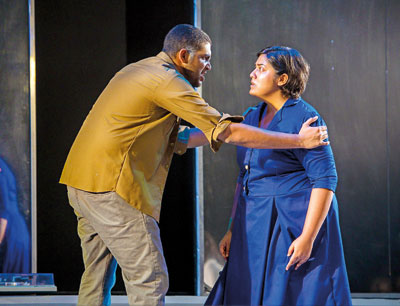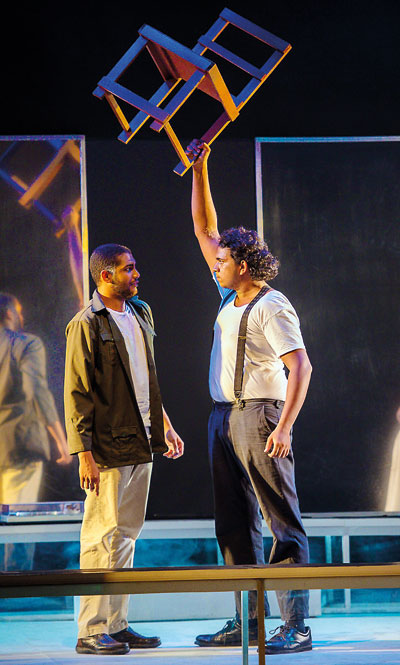Arts
Power of human emotion

Emotions run high: Eddie (Kanishka Herat) with his wife Beatrice (Dinushka Jayawickreme) and below, a confrontation with Marco (Lihan Mendis). Pix by Dilanjan Seneviratne
Jerome de Silva and his Workshop Players have grown over the years into a much loved theatre company, known for their glamorous renditions of big American musicals. In Arthur Miller’s “A View from the Bridge” they had a very different challenge.
The set and concept for the play borrowed heavily from director Ivo van Hove’s Broadway and West End versions. The stage is stripped, leaving a single box-like structure made of transparent benches which form a ring around the actors. There are two doors, one leading out on to the street, one leading deeper into the house, and only the essential props: a chair and a record player. This is the home of the Carbone family and their guests, the little box inside which they must all cage their emotions until they explode.
The concept worked miracles for the Belgian director. With no distractions, the audience is forced to dive into the avalanche of emotions that protagonist Eddie Carbone is struggling and failing to hold at bay. The context might be odd for some; a neighbourhood of Italian immigrants in 1950’s Brooklyn. But the visceral nature of the production brings out love, desire, jealousy, anger and the inability to control events that one has unwittingly started in a moment of blind rage; none of which is alien to any audience.
At the Young Vic Theatre in London where van Hove’s production was originally staged, the audience sits in the round, on three sides of the “stage” where the action takes place. Similarly, at the Lyceum Theatre in New York, part of the audience was allowed to sit on stage, sometimes a mere ten feet away from the actors. Ivo van Hove won in an intimate setting.
At the Lionel Wendt, with the stage and sides stripped of curtains, the rafters and empty spaces on the side exposed, the effect was more of remote coldness to an audience seated at a conventional distance from the action. Standing ovations are comparatively easier to get in Colombo, as long as there are lights, action and a touch of glamour, but audience response on opening night was more mixed than unanimously enthusiastic. It felt that the much loved and respected Workshop Players would have won much admiration for a very different sort of production than what they are generally associated with, if the venue had been a more intimate one.
Despite this problem of the space, and despite the minimalist presentation which is unfamiliar to their faithful audience, the Workshop Players communicated profoundly, and credit must go to an excellent cast of actors.

Eddie Carbone, whose obsessive love for his niece finally destroys his family, was played in a most sincere fashion by Kanishka Herat. He left no need for the audience to rationalize his actions and emotions, but simply took us unquestioningly with him, as he was driven from one level of desperate action to another, until his unexpected and violent death.
Eddie’s wife, the typical homely mother-figure Beatrice, was played very naturally by Dinushka Jayawickreme.
Playing their niece Catherine, Mayanthi De Silva’s posture very effectively communicated the character of unsuspecting innocence, though her voice and expression at times seemed somewhat forced. Over the course of the play, Catharine learns to take control of her fate, and De Silva became visibly more confident in her performance, as her character matured.
Catherine’s love interest, Rudolpho, who sparks off the turbulence in the household, was played by Rehan Amaratunga, and his brother Marco by Lihan Mendis. Marco becomes increasingly more important towards the end of the play as the role of antagonist is taken from Rudolpho and put in his hands, and the transition from quiet complacency to watchfulness and outright rage was handled smoothly by Mendis. Amaratunga was convincing both in Rudolpho’s flamboyance and his gentle frustration – a combination not easily portrayed together.
The tragedy is narrated by Alfieri, another immigrant now ascended to the “curse” of practising lawyer. There is an aura of respectful fear that the neighborhood affects towards him, wonderfully brought out in the cleverly directed chorus scenes. It felt nevertheless that Anuk de Silva did not make full use of the potential of his character on opening night: that his rather distant performance failed to communicate and respond adequately to the developing pathos of Eddie Carbone’s fate.
As an ensemble, the players were remarkably strong in their performance, with even smaller roles such as Mike (Eshan Thilakasena) and the immigration officer (Joshua Joseph) portrayed with a sense of identity in the case of the former, and purpose in the latter. There were also many moments of silence in the play, none of which felt contrived or uncomfortable thanks to the natural intensity of the play and the sustained tensions between the actors.
The play was fast paced and the flow well modulated by the team who made full use of the stripped stage and undivided attention of the audience.
An intense focus on the actors implies that lights must be cleverly and cautiously handled, which was unfortunately not the case on Friday, October 7. Shadows fell across the actors’ faces every time two or more were placed together in any corner of the box, creating a significant disturbance to the audience. Sound effects, again, inspired by the van Hove production were handled sparingly and gently by Jerome de Silva himself, with a controlled approach.
To bring the emotional realities of a 1950’s neighbourhood of Italian immigrants living in the United States to a Colombo audience in 2016 is no small feat. The whole company must spend months deconstructing their physical and psychological realities, to become completely new persons onstage. De Silva has expressed great faith in his players by presenting them with an unfamiliar challenge, and the players themselves stepped smartly up to the mark, presenting Colombo with something new to think about.

